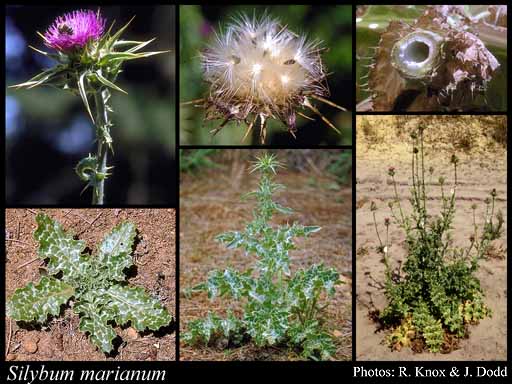- Reference
- Fruct.Sem.Pl. 2:378 (1791)
- Conservation Code
- Not threatened
- Naturalised Status
- Alien to Western Australia
- Name Status
- Current
Erect, robust, spiny annual or biennial, herb, 0.3-1.2 m high. Fl. purple, Oct to Dec. Sandy & loamy soils. Weed of waste places & pastures.

Distribution
- IBRA Regions
- Avon Wheatbelt, Geraldton Sandplains, Jarrah Forest, Mallee, Swan Coastal Plain, Warren.
- IBRA Subregions
- Geraldton Hills, Merredin, Perth, Southern Jarrah Forest, Warren, Western Mallee.
- IMCRA Regions
- WA South Coast.
- Local Government Areas (LGAs)
- Albany, Boyup Brook, Bridgetown-Greenbushes, Bunbury, Chapman Valley, Dardanup, Denmark, Donnybrook-Balingup, Harvey, Kellerberrin, Kondinin, Manjimup, Stirling.
Management Notes (for the Swan NRM Region)
General Biology. Growth form. Herb. Life form. Annual. Reproduction. This species reproduces almost entirely by seeds that are equipped with a large 'parachute' of bristles that enhances dispersal by wind.. Dispersal. Seeds are spread predominately by wind, a contaminant of agricultural produce and to a lesser extent by water, animals, vehicles, machinery and in mud.. Seedbank persistence. Seeds can be viable for at least 9 years. Tilling, overgrazing or other soil disturbance will cause these dormant seeds to germinate.
Notes. Upright and short-lived thistle usually growing 90-180 cm tall. Basal rosette of large variegated leaves (25-60 long and 12-30 cm wide) at first. Leaves are variously lobed and with rigid yellowish-coloured spines (5-12 mm long). Purple flower-heads (up to 13 cm across) with several rows of large, stiff bracts (about 4 cm long) ending in large sharp spines. Mottled seeds (5-8 mm long) with a tuft of numerous silky bristles (12-20 mm long)..
Additional information. Origin. Native to southern Europe (i.e. France, Portugal, Spain, Albania, Bulgaria, Greece, Italy and Yugoslavia), north-eastern Africa (i.e. Egypt) and western Asia.. Similar exotic species. Cynara cardunculus, Onopordum acanthium, Onopordum illyricum, Carduus nutans subsp. nutans, Cirsium vulgare, Cirsium arvense, Carduus pycnocephalus and Carduus tenuiflorus..
Suggested method of management and control. Remove plants manually when ever you see them. Plants in flower can form viable seeds even after they are dug up, so carefully bag and dispose of all flowering plants. If in seed, carefully cut off the seed head and place in a bag to prevent dispersing the seeds. Selective Broadleaf Herbicides (such as aminopyralid, 2,4-D, metsulfuron and dicamba) are most effective Apply selective herbicides with a non-ionic surfactant in the spring before any flowers appear. The best control is early in the spring after growth begins. Glyphosate: glyphosate (450g/L) Roundup CT® M Spot spray 1L/100L Conservation areas, bushland and other non-crop areas. Non selective, avoid contact with desirable plants. can effectively kill milk thistle and any other vegetation including grass. Treatment with glyphosate needs to be combined with effective re-vegetation of the site to prevent milk thistle seedlings from re-infesting the area. Monitor the area for germinating seedlings or plants missed by the initial application. Read the manufacturers' labels and material safety data sheets before using herbicides. For further information consult the Australian Pesticides and Veterinary Medicines Authority to determine the status of permits for your situation or state.
Management Calendar
| Calendar Type | Jan | Feb | Mar | Apr | May | Jun | Jul | Aug | Sep | Oct | Nov | Dec | Comments |
|---|---|---|---|---|---|---|---|---|---|---|---|---|---|
| Manual Removal | Y | Y | Y | Y | Y | Y | Y | Y | Y | Y | Y | Y | |
| Flowering | Y | Y | Y | Y | Y | ||||||||
| Herbicide Treatment | Y | O | O |
Legend: Y = Yes, regularly, O = Occasionally, U = Uncertain, referred by others but not confirmed.
References
- King County Noxious Weed Control Program (2010) Best Management Practices - Milk Thistle. King County URL: https://www.nwcb.wa.gov/images/weeds/Milk-Thistle-Control_King.pdf - Accessed May 2019.
- PIRSA (2017) Weed Control Handbook for Declared Plants in South Australia July 2017 Edition. South Australian Government URL: https://pir.sa.gov.au/biosecurity/weeds_and_pest_animals/weeds_in_sa - Accessed May 2019.
- Queensland Government (2016) Weeds pf Australia. Identic Pty Ltd for Biosecurity Queensland URL: https://keyserver.lucidcentral.org/weeds/data/media/Html/silybum_marianum.htm - Accessed May 2019.